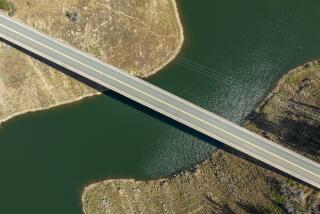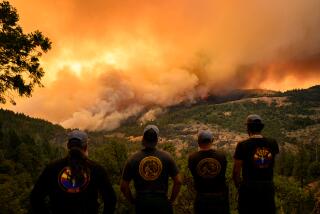Drought Plays Havoc With Fish and Wildlife Throughout U.S.
- Share via
Skunks, elk, opossums and other wildlife, driven in part by lack of food and water in drought-stricken California and Nevada, are coming down from the hills this summer to invade suburban back yards and farmers’ fields in search of food.
In Colusa County in Northern California, state game officials are planning to trap tule elk that have trampled over fences to dine on farm fields, especially melons. In Nevada, state officials have scheduled a summer hunt to reduce herds of voracious deer whose appetite for lush green alfalfa fields has been swollen by the drought.
“When conditions get the way they are, they (wildlife) are going to move to where they can get food,” said A. E. (Spike) Naylor, drought coordinator for the California Department of Fish and Game. “This year is bound to be unusual. Wildlife are going to get into problems, and people should be patient.”
More worrisome to wildlife officials is the potential for mass deaths and reduced reproduction of birds, fish and mammals throughout the drought-stricken areas. State and federal wildlife officials predict the drought may reduce the survival of fawns late this summer and the reproduction of upland game birds such as pheasant and quail. Migratory patterns and routes for many birds will change and fish catches may be down in years to come.
Already, fish deaths have occurred throughout the nation’s drought belt. In California, low water levels and high water temperatures are threatening striped bass and winter-run chinook salmon and stopped state officials from stocking many lakes and streams. In the Dakotas, high water temperatures have halted or sharply cut production of walleye, Northern pike and bass at federal hatcheries.
Ducks are being hard hit as their normal nesting wetlands in Canada and the upper Midwest dry up. The 1988 population of pintail ducks is the lowest ever recorded--2.6 million or 54% lower than the average annual population from 1955-1987. Federal officials project a fall flight of 66 million ducks, the second lowest on record, and plan to curtail duck hunting sharply this fall and winter.
In Southern California, where wildlife is accustomed to a desert environment, the drought’s impact is minimal. Bruce Cahill, a biologist for the Los Angeles County agricultural commissioner’s office, said the number of complaints telephoned into his office about wild critters disturbing residential areas is about normal for a summer. “We aren’t really facing any onslaught,” he said.
But Jaime Meraz, district supervisor for the Baldwin Park shelter for the Los Angeles County Animal Care and Control Department, said calls from residents who want skunks removed from their yards has leaped from two or three a day in most summers to at least seven a day this summer. Similar calls about opossums have doubled to 10 a day.
“Everytime we get a dry spell like this we get an awful lot of skunks coming into the city to seek water,” said Meraz, whose district includes such foothill areas as La Canada Flintridge and Altadena.
Earl Lauppe, wildlife management supervisor for the state Department of Fish and Game’s Southern California District, said that so far the only effects of the dry weather on creatures in the Orange County backcountry is that “they’re coming a little closer to us to drink from sprinklers and the like.”
Both Lauppe and Esther Burkett, a Fish and Game biologist in Orange County, said there have been no signs of animals dying off because of the drought.
“We’ve had no calls from citizens and (in this district) there are no plans for special hunts,” Burkett said. “All we can say is, ‘So far, so good’.”
“The real trying time is going to be the end of September and early October, before the fall rains start,” said Jon Fischer, a state Fish and Game wildlife biologist in Los Angeles County who has received reports of increased sightings this summer of deer, bear and mountain lions in Southern California’s foothill communities.
The drought has also altered the behavior of wildlife in parts of Nevada, according to David Rice, chief of conservation education for the Nevada Department of Wildlife. Skunks there have also moved into residential neighborhoods. A woman living outside Reno recently trapped 20 of them, he said. Antelope have moved off their usual summer feeding grounds, and a hungry bear being hand-fed bread by a camper recently “took a swipe” at the man when the bread ran out. The camper suffered scratches and minor wounds.
“There’s no doubt that bears are finding it hard to find a decent meal,” Rice said.
Conflicts between deer and farmers in Nevada also have been “aggravated” by the drought. “In some areas we have deer coming down looking for food,” Rice said. Most of the poaching of farm fields, however, stems from an unrelated boom in the deer population.
Water Temperatures Kill Fish
Although no lakes have yet gone dry in California, fish have not escaped the effects of a second consecutive dry year. Macumber Reservoir in Shasta County experienced a major fish kill recently when the water level dipped so low that the unusually hot summer--the mercury recently peaked at 118 degrees there--raised water temperatures above the level fish can tolerate.
To prevent a similar problem in a major salmon fishery in the Sacramento River, the U.S. Bureau of Reclamation, under pressure from state fish and game officials, agreed to release 4,000 cubic feet per second into the river from Shasta Dam.
It is a costly gesture because the water is lost for irrigation, municipal uses and the generation of hydroelectric power. Water for power is taken from the lake’s warm surface; the chillier water for salmon spawning is released directly through the bottom of the dam, one of the world’s largest. Federal officials estimate the loss of electricity at $70,000 a day.
In the Sacramento-San Joaquin Delta, the drought is expected to result in lower production of striped bass and lower survival of chinook salmon smolts passing through on their way to the sea. In rivers below the diminished New Hogan Dam in Calaveras County and the Camanche Dam in San Joaquin County, most of the rainbow trout population will be lost because of warm water temperatures, according to state wildlife officials.
Number of Deer Declines
Deer numbers are also down in California’s Mendocino and Lake counties, and officials suspect the culprit may be disease, spread by large concentrations of animals gathering around scarce waterholes. Federal wildlife officials say deer, bear, turkey, squirrels and boar may have trouble surviving a hard winter in southern and midwestern states because of a near total failure of the acorn crop there.
The drought picture for wildlife is not all gloomy, however. Some species are booming.
Dungeness crabs, which generally fare better during periods of low freshwater flows, are thriving in the San Francisco Bay this year. Endangered butterflies, including the San Francisco Bay checkerspot, are flourishing in California because the dry weather has suppressed the growth of fungus that kills their larvae. In the Great Lakes region, gulls, terns and other birds that nest on the shores are reproducing unusually well during the drought because of the lowered lake levels.
The effects on other wildlife may not be known for six months or even a year, said David Klinger, a spokesman for the U.S. Fish and Wildlife Service.
“If it started to rain next week, we still might be talking drought impact on wildlife next winter and spring,” he said. “There is just going to be less food out there for them to subsist on.”
Maura Dolan reported from Los Angeles and Mark A. Stein from Redding, Calif.
More to Read
Sign up for Essential California
The most important California stories and recommendations in your inbox every morning.
You may occasionally receive promotional content from the Los Angeles Times.











